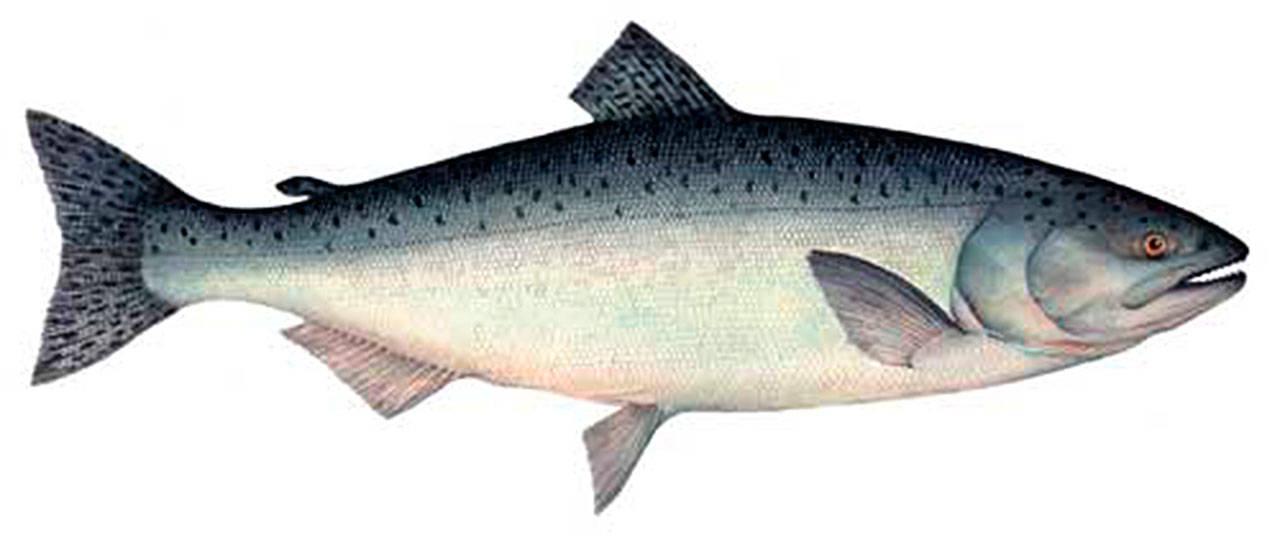IT’S NEVER TOO early to think about the return of salmon to marine waters and state rivers and in what strength these species will return.
Especially considering negotiations for the 2018 summer/fall salmon seasons will begin soon.
Each year, state, federal and tribal fishery managers gather to plan the Northwest’s recreational and commercial salmon fisheries. This series of meetings — involving representatives from federal, state and tribal governments, and recreational and commercial fishing industries — is known as the North of Falcon process.
Quilcene’s Ward Norden, a former fisheries biologist and owner of Snapper Tackle Co., weighed in with his projections at last week’s meeting of the East Jefferson Chapter of Puget Sound Anglers’ recent meeting in Port Townsend.
He’s been on target with these projections in the past, correctly predicting larger coho returns than the state believed in 2016 and smaller than expected pink numbers in 2017.
“As always, it is a political decision by Fish and Wildlife whether sports anglers [the taxpayers] are allowed to fish for the fish we paid to raise in hatcheries, not a biological one,” Norden said. “The numbers of returning hatchery fish is irrelevant even when naturally produced salmon are virtually nonexistent such as chinook in Hood Canal.”
Springers
Norden believes 2018 will bring good numbers of springer chinook back to the Columbia River and to the Sol Duc here on the North Olympic Peninsula.
“This should be a grand year for spring chinook. I think returns will be up at least 20 percent over last year in the Columbia River and in the Sol Duc.”
Summer chinook
The majority of chinook returning to Puget Sound and the Hood Canal are summer run, arriving in their largest numbers in July.
“The place to watch will be in Makah Bay [Neah Bay] in late June or early July for returning kings to the Makah hatchery if that fishery is open to sports anglers at that time,” Norden said.
Norden believes anglers will not have the opportunity to fish for surplus hatchery kings in Hood Canal, and that hatchery returns will be down about 10 percent.
Coho
Norden believes silver runs will take a hit this year on the coast but improve along the Strait of Juan de Fuca and Puget Sound.
“Coastal runs should be down at least 20 percent due to below normal ocean feeding conditions early last summer, but up 10 percent for resident coho in Puget Sound and the Straits due to excellent feeding conditions and below normal fishing opportunities last year,” Norden said.
Pinks
Even though the historical nature of pink runs have produced bigger numbers in odd-numbered years, Norden thinks plenty of humpies are coming this summer.
“Pink salmon returns in 2018 will be far superior to 2017 because the spawning population is still intact for even number years,” Norden said. “Returns to the Snohomish River system will be well over 175,000 and some new populations from other rivers are now contributing.
“Even numbered year’s pink runs are a month earlier than odd years and this year’s will not be an exception. The pink run this year will be in July and early August and will average about a pound smaller due to a month less time at sea. Hopefully there will be an opportunity to fish in Area 9 at least from the beaches with jigs.”
Fall kings
“Most of our fall chinook runs return to the coast or the Columbia River and they were hard hit by ocean conditions a couple years ago, so they should be down at least 10-15 percent below last year,” Norden said.
Halibut catch card bill
Legislation to introduce a $5 halibut catch record is moving through the state legislature.
Senate Bill 6127 establishing a halibut catch record card for a fee of not more than $5 was passed earlier this week on a 12 -0 vote with three excused absences in the state House Agriculture/Natural Resources executive committee hearing.
There was one amendment to the bill which excludes charter stamps and one-day fishing licenses from the $5 fee.
The bill now goes to the House floor for a vote.
Sequim angler Dave Croonquist has been watching this bill closely.
“Thank you to everyone who has helped with this process,” Croonquist said. “If it passes the House, the Senate will need to concur with the amendment before the bill goes to Governor Jay Inslee for signature. I don’t any problems with the Senate. If signed off by the Governor, the fee goes into effect 90 days after passage, effectively putting the fee in place for the 2019 season. It will be interesting to see how many folks are really fishing for halibut in Washington waters.”
Low tide walk
A guided low tide walk to “find out what marine critters get up to after dark” will be led Monday night by Port Townsend Marine Science Center staff and volunteers.
The walk will be held at North Beach County Park in Port Townsend from 6:30 p.m. to 8:30 p.m.
Low tide (-1.5 feet) is set at 7:11 p.m.
The walk is free and open to the public with donations accepted.
Attendees should wear weather-appropriate clothing and bring along a flashlight or headlamp.
RSVP to James Swanson at jswanson@ptmsc.org or phone 360-385-5582, ext. 115.

